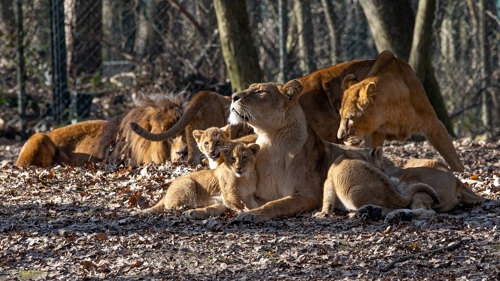
Hundreds of extraordinary animal species live at Burgers' Zoo. European population management programmes for endangered species regularly involve exchanges of animals between zoos across Europe (and sometimes beyond). There is a lot involved in planning and organising this type of transportation, including taking into account the natural behaviour and specific characteristics of an animal species, which also play a significant role in the process. In this series, we highlight several special animal transports. This time: the lion.
Lions are protected by CITES legislation, which means that you need to have the right CITES paperwork to transport them. CITES is an abbreviation for Convention on International Trade in Endangered Species. The legislation combats the illegal trade in endangered animal and plant species. As every country and zoo have their specific regulations, we also need to know the regulations for the destination country and zoo in question. For example, British and Eastern European zoos impose many requirements on the preventive examination of the animal before transport.
Lions are all dewormed, and every feline at Burgers' Zoo is vaccinated against feline panleukopenia and cat flu as a cub. They receive a primary vaccination at six weeks and a booster when between nine and twelve weeks of age. We also test the lion's faeces for parasites and bacteria. In any case, all animals—a lion is no exception—can only travel if the vet has given them a clean bill of health.
In the weeks leading up to the transport, the veterinarian anaesthetises the lion using a blowgun. When the animal is unconscious, a blood sample is taken for the preventive tests required by the destination country or zoo. The opportunity is often also used to check the animal’s teeth, and hair samples are taken for DNA research. The lion can be transported if all test results are positive and the required paperwork is completed.
The veterinarian anaesthetises the lion again on the day of transport, after which the zookeepers lift the heavy animal on a sling into the transport box. After checking that the transport box is properly secured, the veterinarian gives the lion an injection to wake it up. The journey can only begin when the animal reacts to its surroundings again, for example, when it is sitting or lying down.

In addition to the specific medical procedures described above, a veterinarian faces some interesting challenges regarding the medical care of lions. First of all, lions often recover from injuries surprisingly quickly, as do many wild animals. Sometimes, two animals may fight to establish the hierarchy between them. An animal that looks seriously injured often looks much better after just a few days. The natural recovery capacity of wild species remains impressive.
When a lion is suffering from something, such as an infected tooth, the animal's instinct is to try and hide it for as long as possible. In nature, when you show weakness, enemies or rivals try to take advantage of it. That is why the zookeepers must always keep a close eye on their animals: are they eating well; do they look healthy; are they behaving naturally? It is with good reason that the veterinarian calls the zookeepers and biologists his eyes and ears in the zoo!

At Burgers’ Zoo, we prefer animals to raise their young without zookeepers’ intervention. Young anim…
5 August 2022

Early this morning our zoo vet Henk Luten applied vasectomy to an 11-year-old male lion. The lion ha…
11 March 2021

On Thursday, 4 February 2021, the three young lions received their second and last vaccination again…
4 February 2021
